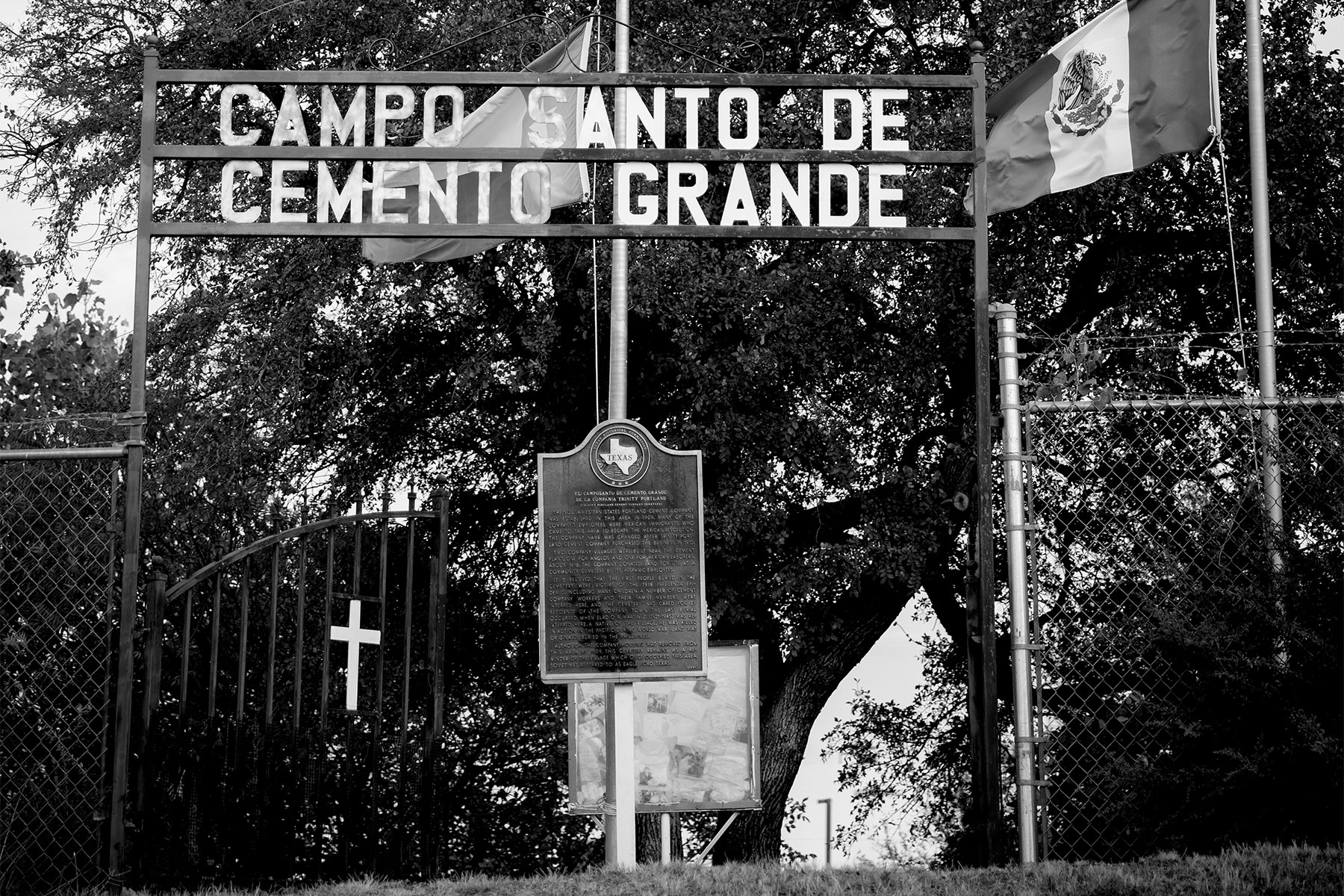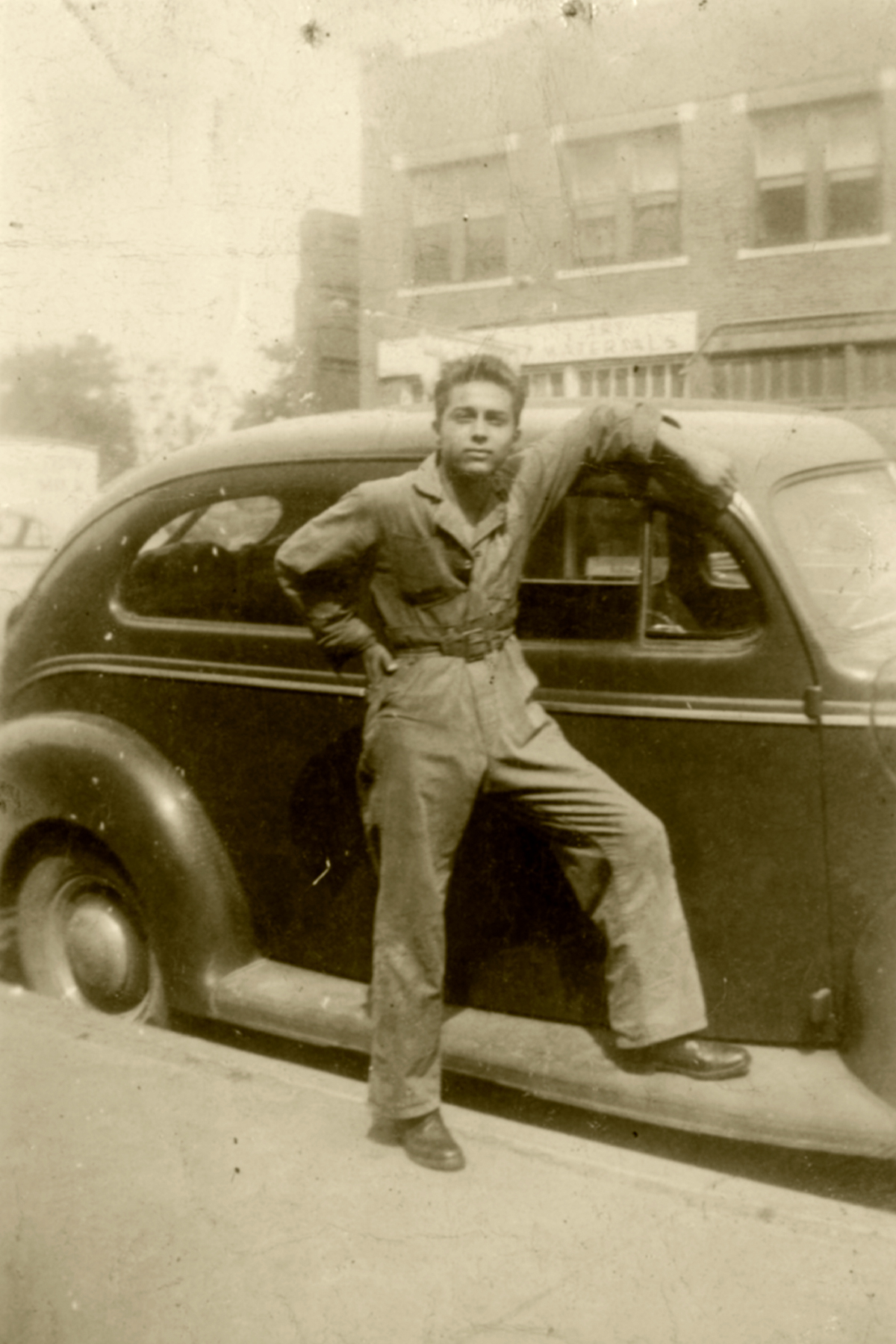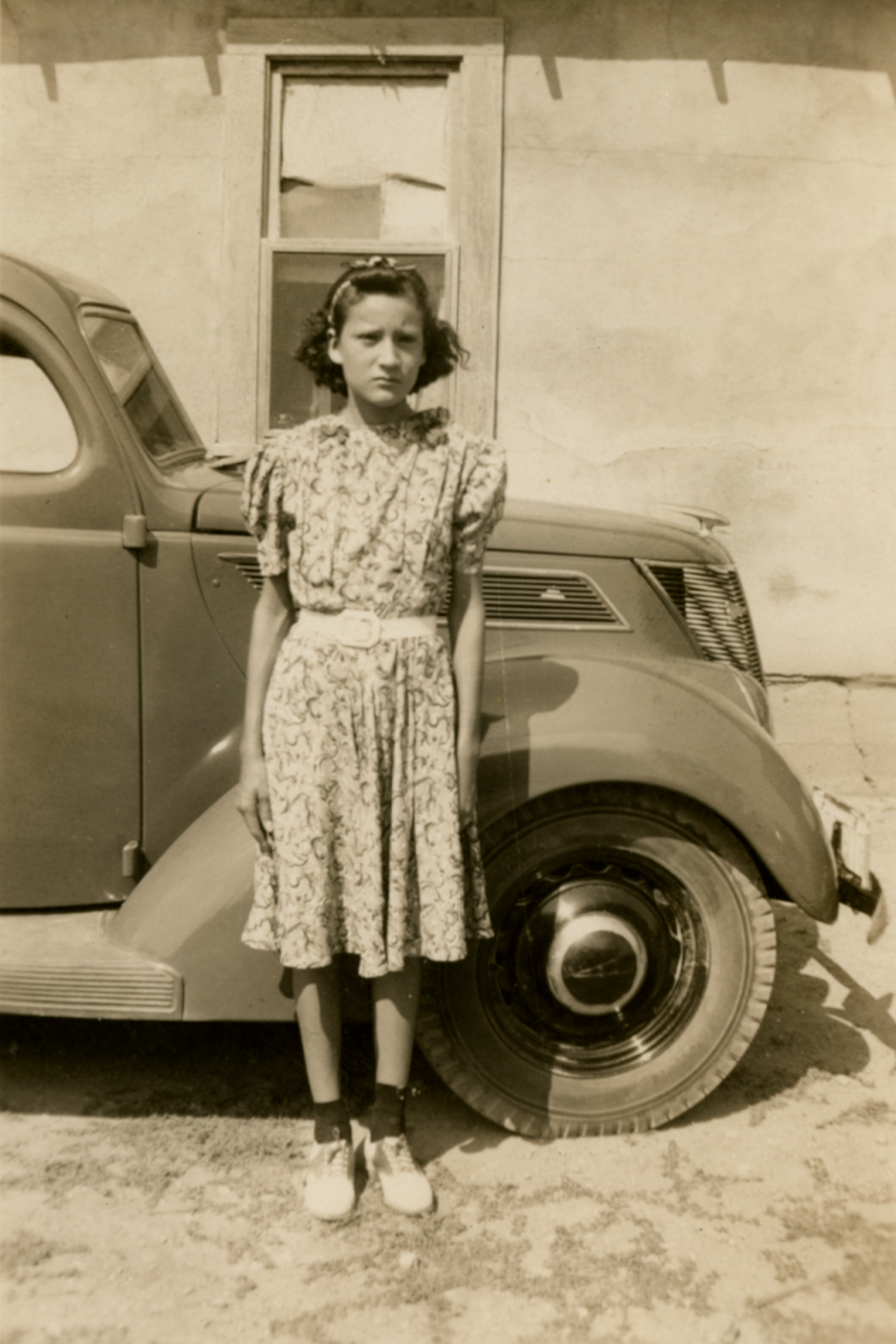Faded photographs are among the few things left of what once was. Of those buried in this cemetery and those who’ve tried their best to keep their memory alive. Those moments captured so long ago that it’s difficult to tell if they were always black and white or if the sun, day after day, year after year, ate away at their color. A few have faded to nothing. Only a yellowish-white piece of paper remains. Some photographs are cracked and crumbling, like they might disintegrate into dust in your hands.
They hang, arranged like a collage, inside a thin case exposed to the outside world. From the rain and sun, the snow and dirt, the wind and time, part of that case has rusted. It’s a few steps inside wrought-iron gates and a sign. Campo Santo de Cemento Grande, it says. Weeds hide a few of the dozen or so markers that remain. The unruly plants are trying to reclaim the land that was Dallas County’s first Hispanic cemetery. A Mexican graveyard, to be exact. Once found, some markers have legible names and dates of life and death. Other gravesites are distinguishable only by what looks like a regular brick. If ever engraved, those words have vanished.
Three large flags—of the United States, Mexico, and Texas—fly above. Their colors match everything else that’s fading here. Their tatters echo a broken bench leaned against a tree. A few small, angelic statues stand silent with their once-sharp facial features eroded. And in the middle of all of this: a dilapidated shrine that someone must have taken hours to build. It’s made of blue-painted plywood, and it houses, among other things, a statue of La Virgen de Guadalupe, the patron saint of Mexico and long considered the symbolic mother of those who trace their roots back to that country. The shrine’s backside has a hole that looks like a boot kicked right through it.
“They had no gold or silver. They were just workers. We buried their flesh and bones.”
All of it—the photographs, the cemetery, the bodies buried here—tells a story about Dallas, a hidden history that many people don’t know. Maybe it’s because it isn’t often told. Maybe because they don’t want to listen.
For decades, vandals ravished this cemetery. They shot at headstones engraved with names like Martinez, Garcia, and Buendia. When visitors came, they sometimes saw graves that appeared to have been looted. Vandalized so often that one person who watched over the cemetery felt the need to explain that while the coffins held the invaluable, they contained no material worth.
“They had no gold or silver,” Feliberto Martinez used to say of those buried there. “They were just workers. We buried their flesh and bones.”
Those flesh and bones, the once-new photographs, flags, funeral mementos, and headstones—they are all behind a chain-link fence in what some now call Pinnacle Park, around Cockrell Hill Road and I-30. The cemetery once covered 2.6 acres, but all that remains now is a shrinking plot of land. The longest side of the plot measures 126 feet long. The shortest is just 89 feet. It’s in a small corner of a parking lot for some AT&T corporate offices.
Campo Santo de Cemento Grande looks almost abandoned, and it almost has been. For more than 70 years, no one has been buried there. But the Martinez family is hoping it is big enough for one more body.
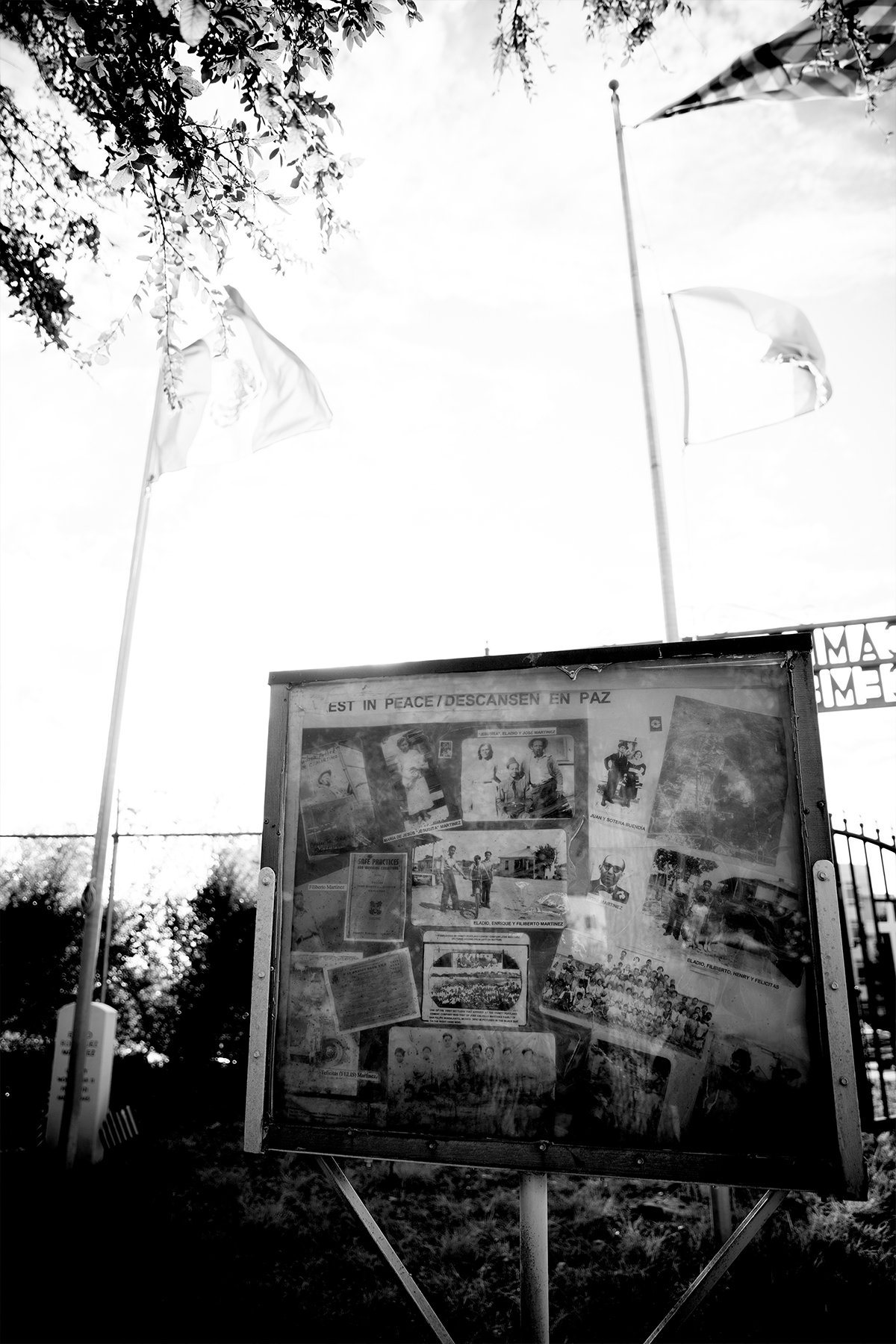
Memories are among the few things left of who Eladio R. Martinez once was. You see his name on historical markers telling you that, in those places where they stand, something else once lived. This wasn’t always an abandoned cemetery overrun by weeds, the markers say. This wasn’t always across the street from a Walmart parking lot.
This place was once alive, and it existed outside of dusty folders kept within various historical archives throughout the Dallas-Fort Worth area. And as you read those decades-old papers and see the names of those who have long passed and others still alive but stripped of their once-vivid memories, this is one of the few ways to understand who Eladio was. Why his name lives on. Why there’s a school, park, and street named after him—all in this place once known as Eagle Ford.
Within those archive folders—some of their papers so brittle you must wear white gloves to handle them—the past is present. Anthropologists kept oral histories of those who can no longer speak. They tell you who the Martinez family was, is, and why they reflect the history of Mexicans and Mexican-Americans in Dallas.
They tell you how the father, José, fled the Mexican Revolution. How he traveled from San Felipe, Guanajuato—the state to which a substantial percentage of Dallas’ Mexican-American population can trace its roots—then paid a nickel to cross from one Laredo to the other. Initially working on the railroads, like the many other Mexicans that laid more than half of the Western tracks, José heard there was work in the cement plants of Eagle Ford. He arrived, and, soon after, he sent for his immediate family. Part of his extended family also came.
It’s there in those archives, in those papers—some over a century old—where you see a place that, today, is unrecognizable. They tell of the physical toll it cost to make this place, Dallas, into what it is. How concrete transformed the skyline and roads. How making the cement for that concrete, which José did for 50 years, was dangerous and bone-breaking work. There was the time a young man’s leg got caught and mangled in the gears of a mixer. He lost consciousness and never woke up. Another time, a worker’s foot got caught in the belt of a shaft. The machine spun his entire body, causing his head to hit a beam. Pieces of his brain sprayed across the work area.
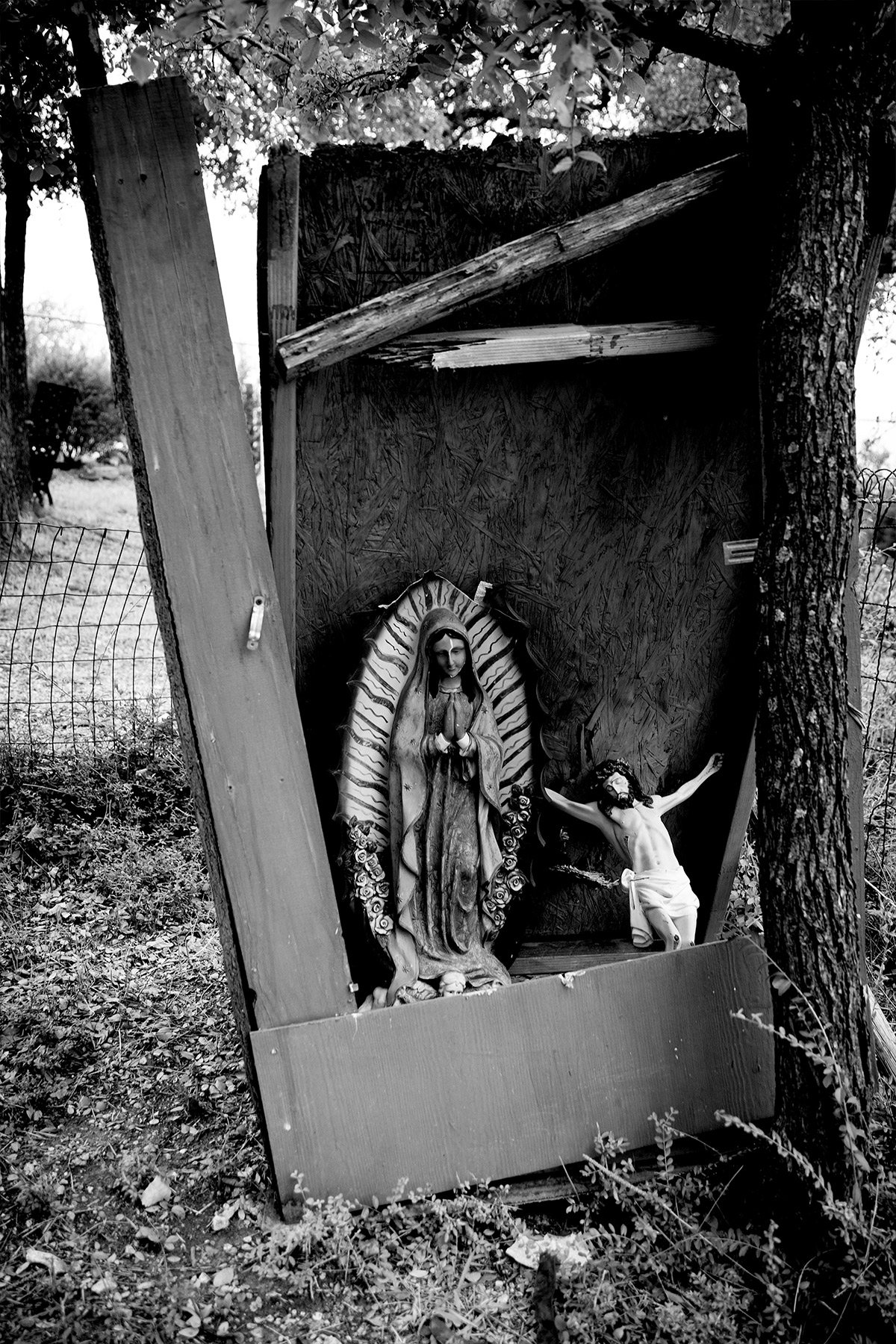
Cement City is where this happened. And although a few of the original concrete boundary posts are still there, it’s difficult to tell what remains of the exact location. Part of Cement City included land once belonging to La Réunion, the Utopian colony founded in 1855. Less than two years later, those dreams of a perfect world failed in part because the otherwise idyllic land wasn’t suitable for farming. But the soil was full of limestone, clay, and schist deposits, each essential for making cement.
At the turn of the 20th century, when Dallas County’s population was just over 82,000, Cement City was the quintessential company town. It had a store that sold essential items on credit. The type that Tennessee Ernie Ford would later sing about, lamenting there was no way he could die since he owed his soul to the company store.
The companies that made up Cement City also built villages for their workers. For $2 a month, they could live in a room. One village was for whites. The others—Campo Grande, Campo Chico, and Eagle Ford—were for Mexicans. Before Little Mexico became a center of Dallas’ Mexican community, only to get displaced by what is now Uptown, these were among the city’s other original barrios. Those barrios were around Cement City because Mexicans helped make the substance that became the literal foundation for Dallas’ growth.
This is where José Martinez lived. Where he and his wife, Maria de Jesus, arrived, ended their pilgrimage, and raised their family in a community with other Mexican workers who tried to replicate home. A community with contaminated water under a cloud of dust and fumes that came from making cement. A segregated community that faced discrimination just like other Mexican communities in the area.
It was in Pike Park, the centerpiece of Dallas’ Little Mexico, where Mexicans could swim only during the early morning hours. Fifteen minutes before 9, they were hustled out, told to drain the pool, clean it, and put in new water for the white kids to swim in. Dallas’ Lonestar Restaurant Association distributed signs to its members for them to hang in the windows. “No Dogs, Negroes, Mexicans,” the signs read.
And although Eagle Ford wasn’t immune from its own problems, it was the Mexican workers’ community. They made their own beer and celebrated Mexican holidays by singing folk songs of the revolution. Those songs—about Mexico, hope, and people like Pancho Villa and Emiliano Zapata fighting in the face of insurmountable odds to reaffirm their sense of belonging—are still sung today. They became the soundtrack of a hard life for many of the Mexican laborers. Those who knew that even though this was home, their place within it was tenuous.
Some of those workers returned to Mexico when they could. Sometimes they’d return with their children born in Texas. Born in a place and a time where even if you named your youngest son Enrique, the name would become Henry. And as they all got older and the family roots ran deeper into the Texas soil, they returned less often. A few years passed between visits. Then longer.

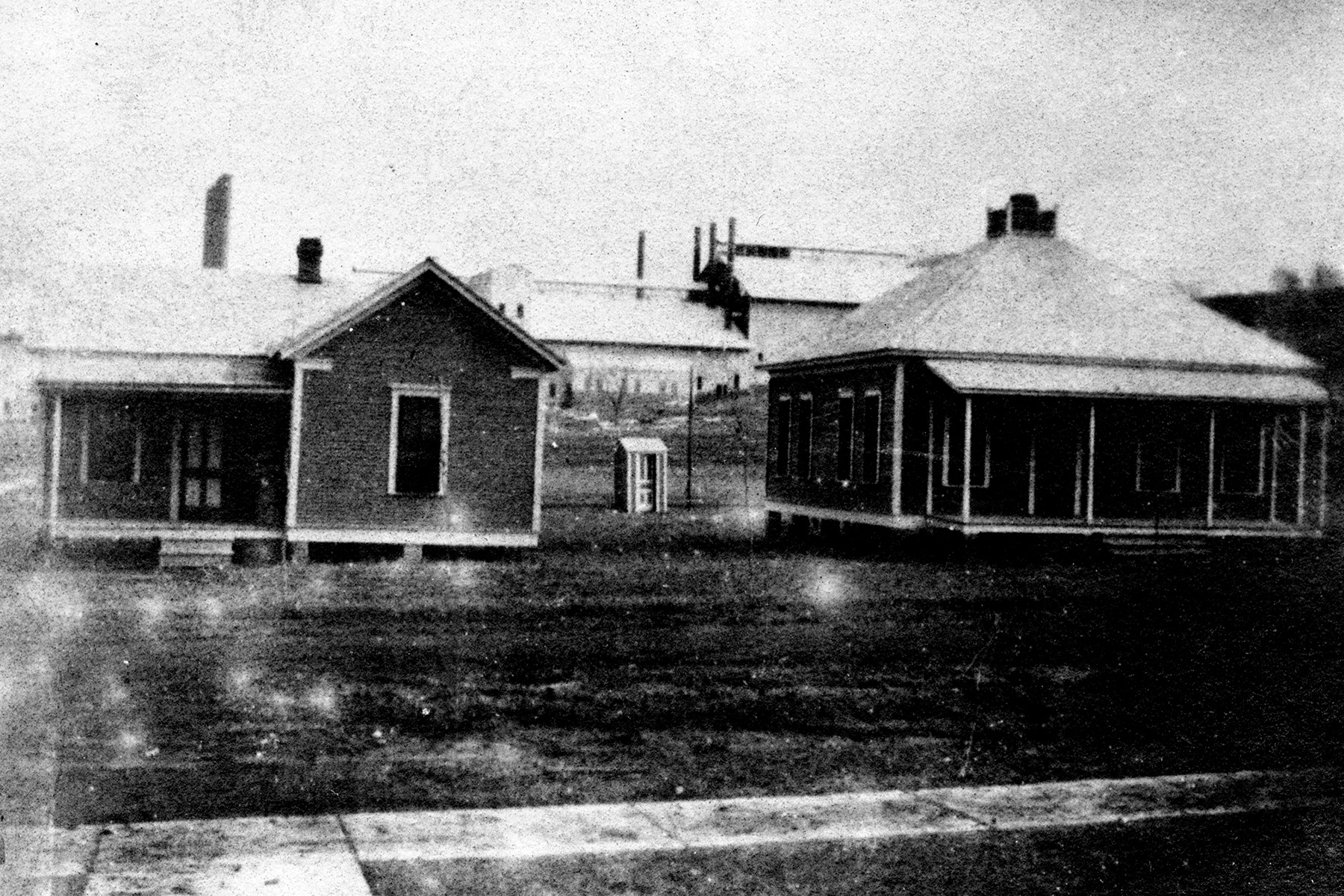
Eladio was the firstborn son of José and Maria de Jesus. More than 70 years ago, Eladio was the last person buried in Campo Santo de Cemento Grande.
Stories are among the few things left of what once was. Oral traditions help preserve a history for people forgotten and often ignored. From one generation to the next, stories get told and, inevitably, altered.
Have you seen a building on Chalk Hill Road that, until recently, looked abandoned? That was Eagle Ford’s elementary school. As the crow flies, it’s less than three-quarters of a mile from Campo Santo de Cemento Grande. Some say ghosts haunt Chalk Hill Road because devil worshippers once practiced their craft in the basement of Eagle Ford’s school. The same school Bonnie Parker attended. The same school that the Martinez kids—Eladio, Feliberto, Felicitas, and Henry—attended.
Sometimes they’d return with their children born in Texas. Born in a place and a time where even if you named your youngest son Enrique, the name would become Henry.
Have you seen that building across the Pearl/Arts District DART stop in downtown Dallas? The one that’s over a century old and was Dallas’ first high school building? It, like the Eagle Ford school, looks increasingly out of place as the surrounding area changes. (The interior has been renovated for the offices of an architecture firm.) Dallas High School, it states on the building’s frieze. But that building was also Crozier High School. That was where the Martinez kids each attended, back when Crozier was a technical school. They’d ride out there on an old, broken-down bike passed from one sibling to the next. Back when Mexicans attended Crozier because those who made the rules believed learning a trade and doing manual labor was the limit of their capabilities.
Often these schools, the ones that taught trades instead of providing an academic education, became the default Mexican schools within cities. Crozier Tech, before it became a business and management magnet, was Dallas’ Mexican school. It taught auto mechanics and metal working. It often restricted Spanish from being spoken. Sometimes parents, wanting their children to assimilate so that perhaps they wouldn’t face the same discrimination they did, told their kids to speak only English—even if they didn’t speak the language themselves.
One story that used to get told much more often was that serving the country led to an easier path to becoming accepted as “American”—that catch-all, flawed descriptor that creates an identity out of geography while often using race to decide who belongs. Theoretically, the story says, if you fought for this country to extend its mythical ideals, then you’d receive a measure of those standards. And so, after graduating from high school, a few years after he signed his mother’s death certificate listing one of the principal causes as “poorly nourished,” a few years after he buried his 37-year-old mother in Campo Santo de Cemento Grande, the military drafted Eladio to fight in World War II. He served in the infantry, on the front lines.
The thing about the stories we tell ourselves is that sometimes they’re rudely and abruptly interrupted by reality. The idea that you would give your life in service of your country, because you were born here, and through that you’d become an equal—it makes sense only until it’s proven false. So long as you aren’t a veteran and a United States citizen who is still deported.
Eladio fought in the Philippines, as did another Mexican-American from Texas, Felix Longoria. “KIA”—killed in action—appears next to Longoria’s name in the National Archives’ military records. He died in 1945. Far from home, far from his young, widowed wife, Beatrice, and the 4-year-old daughter he left behind, Longoria lay buried in the Philippines for years. It wasn’t until 1948 that the Army telegraphed his wife. They told her Longoria’s body was coming home. They asked where she planned to rebury him. Three Rivers, she said. His hometown.
Three Rivers—about halfway between San Antonio and Corpus Christi—had only one funeral home. They refused Longoria’s body because he was “Mexican” and “whites wouldn’t like it.” Desperate, Beatrice sought the help of Hector P. Garcia, a Mexican-American World War II veteran and civil rights activist. Garcia investigated and heard the same response from the funeral home’s owner. “Whites wouldn’t like it.”
“They say that she died of tuberculosis, but I don’t know. To me, she died of sadness.”
Garcia—who incidentally has an elementary school named after him in Grand Prairie—petitioned Senator Lyndon B. Johnson. Long before he served as president, Johnson was a teacher at a school in Cotulla, Texas, about halfway between San Antonio and Laredo. Most of his students were Mexican-American children of farmworkers.
“Few of them could speak English,” Johnson would tell Congress, decades later, “and I couldn’t speak much Spanish. My students were poor, and they often came to class without breakfast, hungry. They knew even in their youth the pain of prejudice. They never seemed to know why people disliked them. But they knew it was so, because I saw it in their eyes.”
Soon after Garcia involved Johnson—who has his own contentious history with Mexican-American politics, often making promises while campaigning and then ignoring them once in office—the family was able to reinter the young Mexican-American in Arlington National Cemetery to end the Longoria Affair.
Like Longoria, Eladio died in combat. “KIA” also appears next to his name. Like Longoria, Eladio died from a bullet shot by a Japanese sniper. Like Longoria, Eladio earned a Purple Heart. And, like Longoria, Eladio lay buried in the Philippines.
When the Martinez family heard their firstborn son had died, his sister, Felicitas, became ill. She was 20 years old when she passed and was buried next to her mother in Campo Santo de Cemento Grande. The death certificate lists tuberculosis as the cause of death. But those close to her tell a different story.
“She was very sad after she heard about Eladio,” Henry Martinez Jr. says of his aunt. “She was devastated. She didn’t want to eat for days. She didn’t want to eat.” Henry Jr. repeats himself, with his soft-spoken voice.
“They say that she died of tuberculosis, but I don’t know. To me, she died of sadness.”
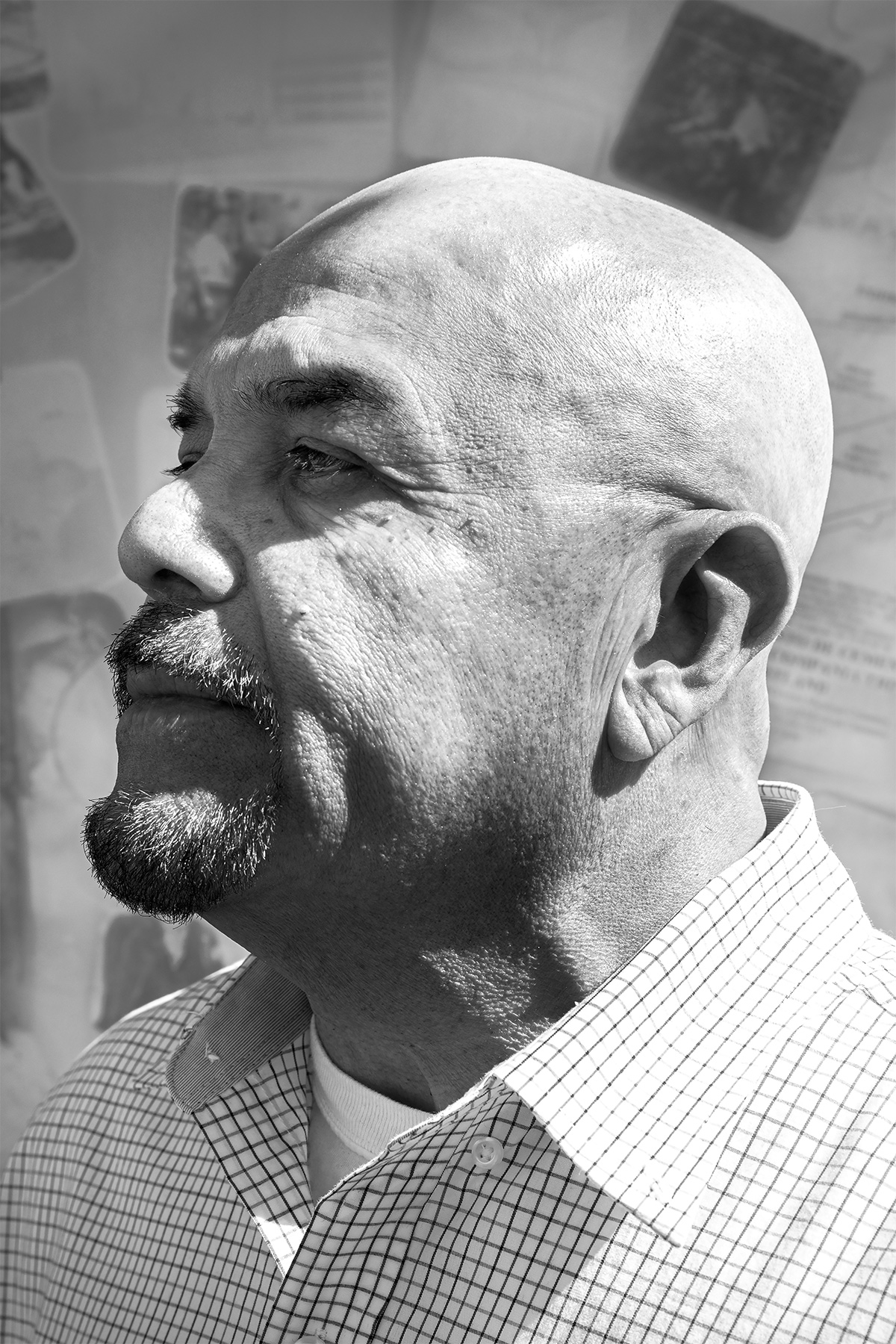
Promises are among the few things left of what once was. After the Martinez family reinterred Eladio’s body in Campo Santo de Cemento Grande, his brothers, Feliberto and Henry, made it their mission to keep his memory alive. In doing that, they also preserved their place in history. Sometimes when you find it hard to belong, you hold on to those with whom you always felt at home.
“My dad, that’s all he talked about,” Henry Jr. remembers. “He said, ‘My brother didn’t come home. I want to do something for him as a memorial because he lived here, he went to school here, and he fought for his country, and there’s nothing here that memorialized him.’ ” So, they did, together, the two remaining Martinez boys. And then it was just Henry Sr.
Feliberto’s obituary from October 2003 stated that after he served in World War II—he was also in the Philippines when Eladio died—he attended art school in Chicago. He dreamed of being an artist. But when he returned to Dallas, there was no work for him. Discrimination is how his daughter explains it. With few other options, Feliberto worked for 32 years in a cement plant.
When Feliberto died, Henry Sr.—the youngest of all the Martinez children, the one who signed his sister’s death certificate, the last person from Eagle Ford before it became incorporated into Dallas—became the last living member of one of the original Mexican families who had come to this part of Texas. The Martinez family, who deserve mention among the other important families in the history of Dallas. The Cockrells. The Santerres. The Caruths. The Marcuses. The Loupots. The Martinezes.
For 50 years, as everything around him changed, Henry Sr. fought to keep the history of his family and birthplace alive. He headed the Ledbetter Neighborhood Association, which helped preserve the Campo Santo de Cemento Grande. When Southwestern Bell (before it became part of AT&T) began building next to the cemetery, Henry Sr., Feliberto, and a few others saved what remains today. The neighborhood association helped raise money to pay for the historical markers that tell you of the things that once were. The places and people who once lived. They tell you of a history that’s often forgotten.
That fight became part of Henry Sr.’s everyday routine. Daily, he’d visit the cemetery and spend hours there. Daily, he’d drop off fresh flowers at the various historical markers representing what was home and the people who once lived there. And as he got older and struggled to walk, the flowers Henry Sr. left became artificial. They lasted longer and saved him the pain of moving as often. As he got older, rather than walking the small hill that leads to the cemetery, Henry Sr. would park curbside instead. He’d sit in his truck, beside that segregated graveyard that some say the cement companies gave to their Mexican workers when they had nowhere to bury victims of the 1918 flu pandemic.
Sometimes he’d think about his mother, sister, and uncle who were all buried there. Other times, he’d think of Eladio, also buried there. He’d think about the last letter he received from him. How Eladio told him, his baby brother, to have his car ready and to tell his girlfriend he was coming home. When Eladio came home, Henry Sr. spent as much time as he could with him.
“When I come here, I can feel that he’s here,” Henry Sr. would say.
It’s why, before Henry Sr. died in August of this year, he said he wanted to get buried in Campo Santo de Cemento Grande. To be there among his family, close to the place where he grew up. Among people who lived and created a community within what some saw as a strange, foreign place far, far away from home.
To get buried among those who died young. Like Guadalupe Pena, who was 15 months old when she died of bronchopneumonia. Or Hurbano Hurta, who died of pneumonia at 6 months old. Or Felisitas Garcia Perez, who was 16 when she died of tuberculosis.
Or Juan Buendia, who died at 21 years old from a shotgun wound to the head. They say a white man killed Buendia because he trespassed and was eating pecans. The white man shot Buendia, loaded his dead body on a horse, and took it back to Eagle Ford—where Buendia lived, where Hurbano, Guadalupe, Eladio, Feliberto, and Henry Sr. all lived. An unnamed white man claimed Buendia had shot first. But those who knew Buendia say he didn’t even own a gun. Buendia’s murderer faced no charges. They say Buendia’s headstone marked a dedication. They say that as Buendia’s body slowly entered the ground of Campo Santo de Cemento Grande, his sisters were inconsolable.
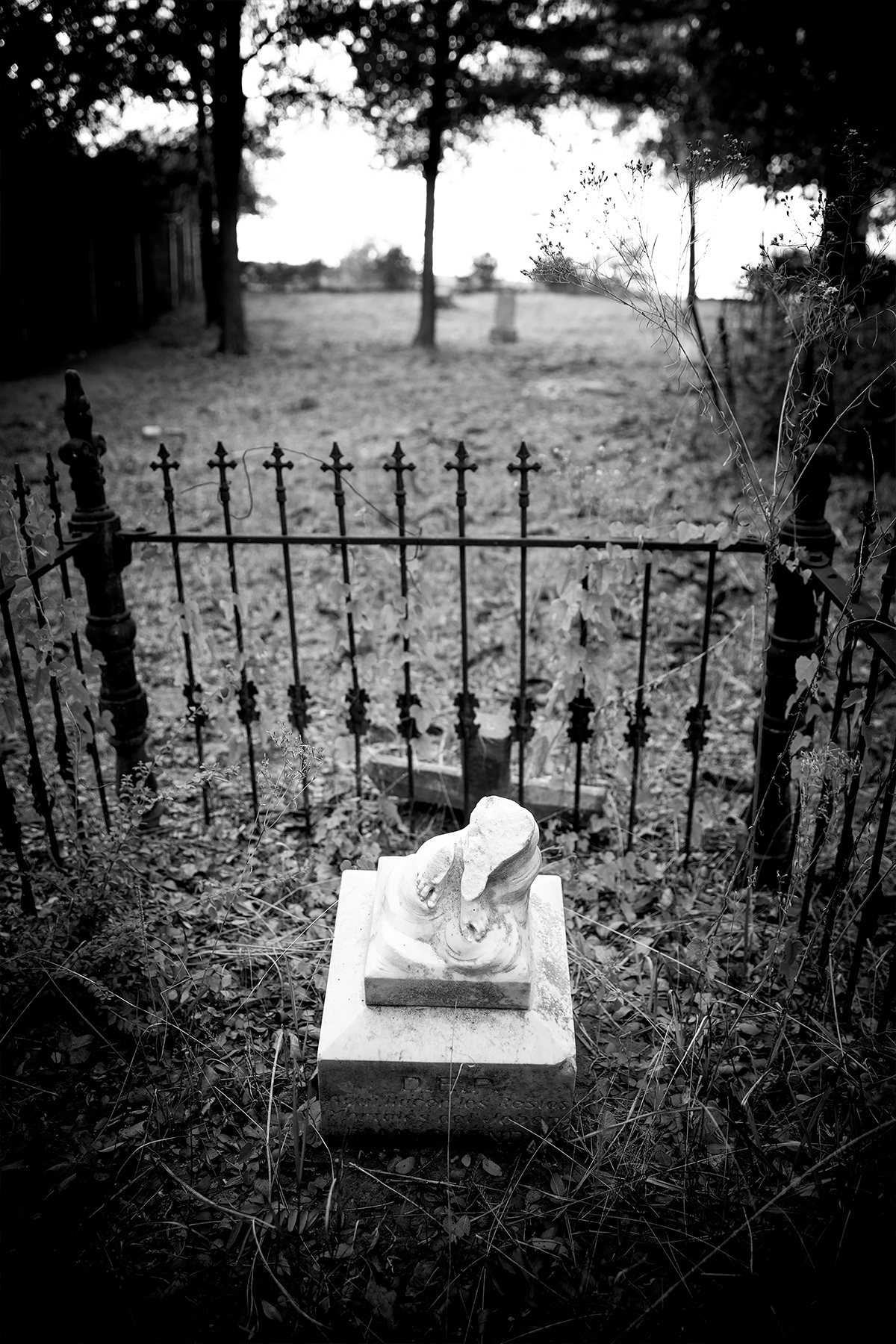 On October 18, 1925, Juan Buendia died. “Laborer” is how his death certificate describes his occupation. It lists his name as John Goodday Jr.
On October 18, 1925, Juan Buendia died. “Laborer” is how his death certificate describes his occupation. It lists his name as John Goodday Jr.
Erased histories are among the few things left of what once was. Dallas—like many cities searching for more—privileges certain histories while ignoring, or forgetting, others.
It destroys and buries part of the past. Sometimes, the only way to recover it is to live, for a few moments, among those who long ago died. Sometimes you must follow them into a cemetery that’s slowly dying. A cemetery like Campo Santo de Cemento Grande, where part of Dallas’ unflattering history lies buried. A cemetery where Henry Martinez Jr. wants to bury his father.
The state tells him he can’t. They fear that since no one knows with certainty the number of Mexican laborers buried there, they risk uncovering a body if they excavate. They tell him that to know, they must run expensive tests—which they won’t do. Henry Jr. remains determined. “I don’t care how much it takes,” he says. “My dad wants to be buried there with his family.”
He says there are Mexican-Americans in Dallas whose families also lay buried in Campo Santo de Cemento Grande. He says they don’t even know it.


